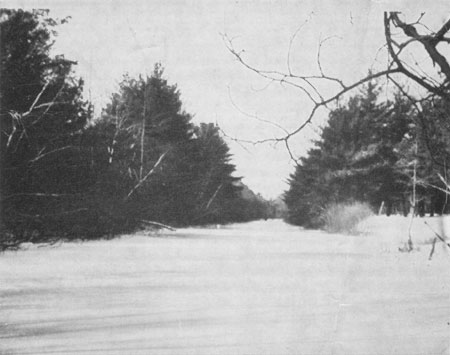

Published by the Middlesex Canal Association
Billerica, Massachusetts
Vol. 3, No. 1 March, 1965
The Canal in Winter

The Canal at High Street, in North Billerica, photographed by Fred Lawson, Jr.
WINTER MEETING-MARCH 16, 1965
Due to many circumstances, including the weather, it has not been possible to schedule our usual skating party. Instead, the winter meeting will take the form of a lecture by Mr. Prescott W. Hall of Melrose, one of our members, who has an excellent talk on the Canal, illustrated with many beautiful colored slides.
The meeting will take place Tuesday evening, March 16, 1965 at 8:00 P.M., at the Woburn Public Library in the meeting room in the basement of the building, which can be reached from the parking lot in back of the building. This is the room where our annual meeting took place last October.
Guests are welcome and refreshments will be served.
CANAL MUSEUM GROWS
Since its opening a little over a year ago, the Canal Museum has been the recipient of many gifts and loans. It already contains copies of most of the magazine and newspaper articles written about the Middlesex Canal. In addition, the originals or copies of many research papers written about the Canal are on file.
Space does not permit a listing of all the material in the collection, but among the items which might attract the most interest are:
The most recent acquisition is a splendid collection given by Mr. James K. Baldwin, including:
To these and to the many others who have donated or loaned material, we express our gratitude. It will be seen that we have now collected a substantial nucleus for the best collection of Middlesex Canal material available to the public.
Any persons having material in their possession can be assured that any gifts or loans will be greatly appreciated and safely preserved.
New Sewer Construction Unearths Timbers of Old Middlesex Canal
Last fall, considerable activity took place at the site of the Old Canal in Winchester, where excavating for a sewer line revealed the base of an aqueduct. The operation and the discovery were described by Mr. Frank W. Lovering in the December 21, 1964 issue of the Medford Daily Mercury. His story is reprinted here by permission of the Mercury.
By Frank W. Lovering
Literally digging into history in Winchester, where the historic Middlesex Canal crossed the strait connecting Upper Mystic Lake and what now is called Bacon's Pond, contractors are preparing to lay a new sewer pipe from the nearby Winchester shore to Mystic Valley pkwy.
This pipe will replace a 16-inch drain which has rusted out. The crew is working with a power scoop in a deep pit drained by the constant operation of several pumps. These throw the water over a circling earthen dam.
A road for trucks to haul away the waste material has been cut on an incline up from the pit along the south side of the picnic ground west of Sandy Beach.
The temporary road parallels that part of the former canal bed marked by a bronze tablet where it leaves the parkway. The road is now covered with hot top and leads to a granite outlook built three or four years ago.
The excavation is just west of the parapet.
Heavy timbers were exposed after granite blocks were removed. The beams are 12 inches square, cribbed up and held together by wooden pins.
They have not rotted perceptibly in 120 years. They are so firmly in place that a great deal of labor is necessary to dislodge and separate them.
The timbers were the main support of an aqueduct which carried the Middlesex Canal there between 1804 and 1836.
The aqueduct was lined with granite on the inside. The granite was protected by both wood and soil. The first aqueduct was built wholly of wood.
The builders of long ago used extraordinary engineering skill to build the aqueduct. First, eight wooden rafts were constructed. Stone walls were built upon these, each wall 10 feet long, six feet high and four feet thick.
The rafts carrying the walls were sunk and formed seven north and south channels each seven feet wide. Through these the water, then tidal flowed to meet the narrow Aberjona river bed which ran through low land from an island near the present Wedgemere railroad station. On the island was a mill operated by a dam in the river.
The dam between the present Upper and Lower Mystic Lakes was built by the town of Charlestown before it joined Boston. The dam formed Bacon's pond.
The water in the Upper Lake flowed by gravity to a pumping station which exists and is used as a Metropolitan District Commission garage on Mystic Valley
Pkwy in Somerville.
The pumps forced the water to a reservoir long abandoned on Tufts University hill.
The stone walls built on the rafts at the Upper Mystic-Bacon's pond location were exposed three feet above the normal water level in the strait. A floor of granite blocks was laid on top of the walls to make a bridge 100 feet long and 80 feet wide.
On the bridge floor were built two parallel granite walls six feet high and four feet thick. The floor between them was packed with clay to form a watertight bottom for the aqueduct.
Earth embankments solidly puddled were built on each side of and over the tops of the walls so the water in the canal flowed as securely in the channel as through natural soil.
The toll canal was in operation 42 years. It was closed in 1846, killed by the advent of the Boston and Lowell Railroad which was opened in 1835.
The railroad followed the route of the canal for miles between Boston and Lowell like an accusing ghost.
Leaving Winchester the canal crossed Woburn just west of the present public library. Six locks were necessary before the waterway reached Wilmington. These locks raised the canal 50 feet.
An aqueduct 160 feet long carried the canal over the Shawsheen river. It met the Concord river at what was then called Billerica Mills. It reached the Merrimac river by a drop of 32 feet.
The Middlesex Canal was first suggested by James Sullivan of Charlestown, a justice of the state Supreme Court. Sullivan sq. is named for him. He was Governor of Massachusetts in 1807-08.
Judge Sullivan pointed out that a canal between Boston and the Merrimac river would inaugurate transportation to Concord, N.H., about 80 miles.
His plan met ready response. The state legislature incorporated "The Proprietors of the Middlesex Canal" in 1793.
Loammi Baldwin, originator of the Baldwin apple was one of the canal directors (The apple was a
“sport” - so listed by the fruit industry and by botanists, because it started wild and was developed into a valuable fruit.)
Gov. John Brooks of Medford was another director.
The route of the canal was surveyed by Samuel Thompson of Woburn who was succeeded as the work progressed by Samuel Weston. He was brought on from Philadelphia. Weston was a civil engineer of great repute. He made his part of the survey with an instrument bought for the purpose in London.
Two routes were laid out. One was adopted by the canal, the other, years later by the Boston and Lowell Railroad.
(Reprinted, by permission, from the Medford (Mass.) Daily Mercury)
1965 Dues
are now payable. Those who have neglected to send them will do, the Association a service by mailing a check to it at P.O. Box 593, Billerica, Mass. New memberships will also, be accepted.
Middlesex Canal Association
P. 0. Box 593
Billerica, Massachusetts